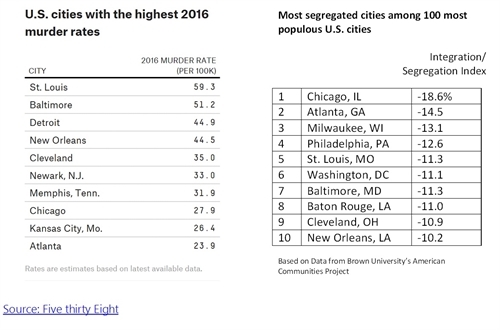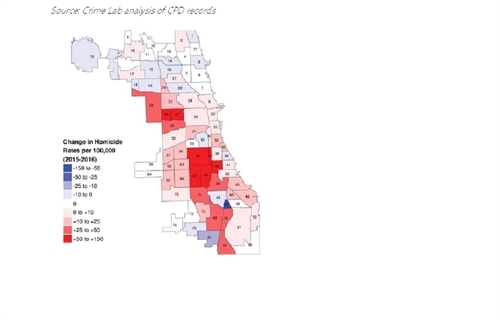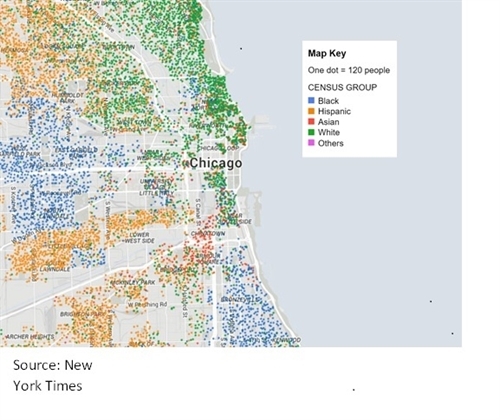Debunking Alternative Facts: The Reality of Chicago’s Violence Problem

In 2016, murders in Chicago totaled 764, a 58 percent increase from the previous year. This sudden spike in gun violence has garnered both national and international media attention, earning Chicago the reputation as the murder capital of the United States. The city’s violence is even a frequent focus of Presidential tweets and press conferences, with federal troops suggested as a possible remedy.
While it’s undisputable Chicago has a violence problem, the White House rhetoric is rooted in alternative facts. According to a recent report by the University of Chicago Crime Lab, we are not alone in experiencing a sudden increase in homicides. Although we have a higher number of murders than our big city counterparts, Chicago’s total homicide rate at 27.8 per 100,000 residents is in the middle when compared to all U.S. cities, and ranks eighth of cities with the highest murder rate.
Everyone has an opinion on what should be done. Hire more police. Mentor youth. Create jobs. Call in the Feds. As a native Chicagoan and South sider, I do not take lightly the need for intervention. Men, women and children are dying and mainly on the south and west sides of the city. We need creative ideas and effective answers but solutions aren’t worth much if they don’t address root causes.
There are many suggested contributing factors for the increased murder rate such as poverty and the loss of safety net services due to the budget impasse, however, violence is a symptom of a larger problem. And perhaps that problem starts with our legacy of separation.

When you look at cities with the highest murder rates and highest segregation rankings there are striking similarities. Seven of the ten most segregated cities also have high murder rates. These cities also have common patterns of poverty and disinvestment concentrated in communities of color.
In 2016, eleven Chicago neighborhoods accounted for more than half the number of homicides in the city. A map of where those murders occurred next to Chicago’s population by race is telling. Communities that see the highest rates of violent crime are also highly segregated by race and class.
Change in Chicago Homicides by Community Area

Chicago Communities by Race

So is there a relationship between segregation and violence? Is the prevalence of violent crime influenced by how populations are situated by income and race?
These are some of the questions The Metropolitan Planning Council is exploring as we research the Cost of Segregation to the Chicagoland region. Our goal is to identify interventions for policy change that will begin to dismantle the current separate and unequal structure we see in Chicago neighborhoods and the region overall.
Public safety is an important indicator of a communities’ ability to thrive. It influences economic investment, property values and population growth. As we question what detriments segregation has on public safety we will focus on four areas: police reform, the geographic concentration of crime and violence, criminal justice policy and how place impacts the reentry and recidivism of people with criminal records.
Building from the work of the Police Accountability Task Force , we are looking at how multi-tiered training for CPD personnel can be localized. Communities can play an important role in collaborative policing such as contributing to the orientation of beat officers to better equip and inform the deployment of staff and resources.
We are learning from other cities to understand what neighborhood level investments work to stabilize communities while creating wealth building opportunities for residents. Efforts like the Evergreen Cooperative Collaborative in Cleveland, Ohio capitalize on the joint purchasing power of five anchor institutions to engage community residents as worker-owners in cooperative enterprises. The collaborative launched green businesses including a commercial laundry service, energy retrofitting and weatherization firm and a hydroponic greenhouse. Employees build wealth through wages and profit sharing and have a voice in operations and governance.
We are looking at how communities are disproportionately stripped of people and resources and how that is worsened by policies like the money bail system and the seizure of property through civil forfeiture. Additionally, as people are released from detainment, policy reform is needed to reduce barriers that limit the opportunity for jobs, housing and family reunification for individuals with a criminal record.
The deliberate segregation of people by income and race has influenced the distribution of resources resulting in a region that is separate and unequal. Chicago’s divide was built by the use of restrictive covenants, urban renewal and redlining. It has continued with predatory lending targeting black and brown communities and the massive foreclosures that followed leaving housing markets stagnant.
As North side communities begin to recover, south and west side neighborhoods are again left behind. Despite some gains in affordable housing and opportunity programs, low-income voucher holders remain limited in their choice and mobility in the private rental market. In a pattern reminiscent of the great migration, thousands of public housing residents forced to relocate found bias and income discrimination rampant as they sought housing options and mostly settled on the south and west side and surrounding suburbs.
In order to reverse this tide we have to be equally deliberate in changing policies that concentrate poverty and isolate opportunity to a handful of zip codes. When we create inclusive communities with good jobs, thriving business and strong schools that cultivate opportunity regardless of income and race then we can say we are safe.
